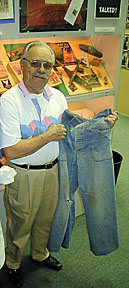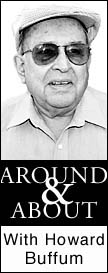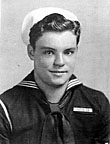

This became known as the Second Battle of the Philippine Sea, the largest naval battle ever fought. The Japanese navy lost more than 30 ships, including four carriers, three battleships, nine cruisers, four submarines and 10 destroyers. American forces lost 10 ships - the aircraft carrier Princeton, the escort carriers Gambier Bay and St. Lo, three submarines, two destroyers and two destroyer escorts.
 That battle ended the Japanese navy's role as an effective fighting
force. America would maintain maritime supremacy in the Pacific for the
duration of World War II.
That battle ended the Japanese navy's role as an effective fighting
force. America would maintain maritime supremacy in the Pacific for the
duration of World War II.
Seaman 1st Class Harold E. "Dusty" Rhodes was one of the lucky ones. He didn't receive a scratch. He was among 141 shipmates, out of 327, who were saved. Forty-five others died in the water from battle injuries. Four were killed by sharks. Ninety others, including the captain, survived the sinking but were never seen again.
The Johnston was leading an anti-submarine screen in the vanguard of the main American formation off Samar Island. Instead of retiring in the face of superior enemy forces, the Johnston chose to engage the enemy ships head-on in a gallant effort to protect the slower carriers and fought for almost three hours before going down.
The destroyer, veteran of six Pacific engagements, left one heavy cruiser sinking and scored damaging blows on another cruiser, a battleship and two destroyers. Both the captain and executive officer were lost, and five other officers and 87 men were listed as missing. One hundred and forty-one survivors were rescued after clinging to their one life raft and several flotation nets for 50 hours.
The battle began at daybreak on Oct. 25, 1944. As soon as the alarm of the Japanese fleet was passed among the U.S. flotilla, the Johnston, even before receiving orders, started laying a smoke screen. The American carriers, sitting ducks as they maneuvered into the wind to launch their planes, required protection by the escort force in the fastest way possible.
 THE JOHNSTON -- The USS Johnston shortly after her commissioning in 1943 and just before she was "sent to war." (File photo) |
The Johnston was not hit until she was retiring after the initial thrust. Three 14-inch shells followed closely by another trio of 6-inch projectiles shattered her hull aft, cutting off power to the steering engine and rendering useless the after 5-inch guns as well as the gyro compass. When steering and all communication from the bridge was lost, Lt. Comdr. Ernest E. Evans shifted command to the fantail from where he shouted steering orders through an open hatch to the men below decks who were turning the rudder by hand. Seaman Rhodes was one of those men. A tropical rain squall afforded a 10-minute respite and permitted the men to extinguish fires that were raging in the after engine room.
When Comdr. Evans spotted a baby flattop under fire from a Japanese cruiser, he issued the order, "Commence firing on that cruiser. Draw her fire on us and away from Gambier Bay." The Johnston scored four hits in the deliberate slug match with the cruiser, then broke off the futile battle when the enemy destroyer squadron was seen rapidly closing on the American escort carriers. The Gambier Bay and another baby flattop were subsequently sunk.
An order was then given for all destroyers to launch torpedo attacks. The Johnston had already fired all of its torpedoes, but instead of retiring she mustered all speed the damaged engine room could produce and fell in astern of the attacking destroyers to furnish fire support. The Johnston did not turn away on completion of the torpedo attack.
On the contrary. Its remaining guns blazing, she moved into the middle of the enemy formation until she was flanked on one side by a cruiser force and on the other by a formation of destroyers. One cruiser came within 6,000 yards, and numerous 5-inch hits were scored upon it until the enemy destroyer force started to converge upon the Johnston. The American destroyer turned in its own smokescreen and maneuvered to engage approaching enemy ships. The lead Japanese destroyer was picked out as the first target and was immediately battered with at least 15 hits. A second destroyer was taken under fire, and it, too, received some damage.
As the range between the lone American ship and the large enemy force closed, the leading Japanese destroyer made a 90-degree turn to starboard and fled from the area with all other destroyers in the formation following suit. It was later believed that the enemy ships turned away because the Johnston, appearing and disappearing in the smokescreen, could have led the enemy to believe that several American ships were maneuvering under the smokescreen.
For the final half-hour, the Johnston held her position between the main American force and the Japanese ships until an avalanche of shells delivered the final blow. The destroyer was abandoned at 9:45 that morning, and at 10:10 she rolled over and began to sink. A Japanese destroyer approached to within 1,000 yards and pumped a final round into her to make sure she went down. A Johnston survivor reported seeing the Japanese captain salute her as the Johnston slid beneath the waves.

Harold E. "Dusty" Rhodes at age 21 |
After some hours in the water, the survivors were spotted by a plane which flew low and dipped its wings. But rescue was still almost two days away. It was later believed that the location given by the spotter plane was garbled in transmission. Knowing there were many survivors somewhere in the region, a coordinated search was launched by five LCTs steaming abreast several miles apart.
"That American flag we spotted on them was the most beautiful sight we ever saw," Dusty commented.
The survivors on the one life raft became separated and after several days landed on a Leyte beach. All the survivors were taken to a supply ship off Leyte where the seriously injured were kept for medical treatment. The others went by LST to New Guinea and there boarded the USS Lurline, a posh Matson liner converted into a troopship. They sailed to Brisbane, Australia, where survivors of four other ships came aboard and the ship set sail for San Francisco in late November.
Dusty's copy of the menu for the Aloha Thanksgiving dinner served in mid-Pacific shows the men fared well. The feast included fillet of beef Wellington and roast turkey.
Dusty still has the V-Mail note he sent his mother after he was rescued. Censorship forbade him to reveal the sinking of his ship, but his words left no doubt what had happened, and the Navy censor let it pass.
This is part of what he wrote her: "My Dear Mom: Well, I guess you can see it has been quite awhile since I have written to you. But it wasn't my fault. Mom, we have met our enemy, the Jap fleet, and there is only one way to explain it, and that is, that it was Hell!! So I'm no longer on the Johnston, but I'm as good as I ever was and feel just fine so their is no need for you to worry at all."
But she had had reason to worry since on about Nov. 15 she had received word from the Navy that he had been wounded in action, which was not the case. As soon as the Lurline docked in San Francisco, he telephoned her.
Born in Sumner County, the son of Bertha (Hatton) and Joseph E. Rhodes, Dusty was 11 when the family moved to a farm east of Arkansas City. In his junior year at Dexter High School, he was drafted and chose Navy service. After boot training at Farragut, Idaho, he was sent to Seattle in June 1943 and assigned to the Johnston as a member of the commissioning crew's deck force.
The Johnston went down only two days short of celebrating her first year of being in commission. The commission pennant was hoisted on Oct. 27, 1943, and by the first of the next year, the Johnston was on her way to the war.
On Feb. 1, 1944, the new destroyer bombarded Namur Island and destroyed a huge structure believed to be a Japanese magazine. During the previous day, the vessel raked the shores of Mellu Island of the Kwajalein group. Light opposition was encountered in both engagements and no casualties occurred.
A five-day bombardment of Eniwetok Atoll, lasting from Feb.17-22, came next. Fire support was furnished to invasion forces, and several pillboxes and revetments along the beach were taken under fire. On March 28, the Johnston, with a primary mission of searching for enemy shipping, bombarded the Kaping Maranga Atoll in the Carolines. An observation tower, several blockhouses, pillboxes and dugouts along the beach were shelled. Working with the aid of a spotting plane, the destroyer steamed into the mouth of the Maririci River, southeast of Empress Augusta Bay, Bougainville, on March 31 and laid a heavy barrage into the area. Between these engagements, the busy destroyer was on anti-submarine patrol. As a result of action on May 16, the Johnston was credited with the probable sinking of a Japanese submarine.
The month of June was spent preparing for a long bombardment of Guam on July 21-29. Firing was conducted throughout the days, and submarine patrols were run at night. The ship was straddled repeatedly but escaped unhit. The destroyer's fire shattered two enemy 4-inch battery installations as well as numerous pillboxes and buildings. The crew became so accustomed to the constant firing that it became customary for the off-duty watch sections to sleep while the ship's guns thundered overhead. The Johnston's final engagement before the Battle for Leyte was the bombardment of the Western Carolines from Sept. 6 to Oct. 14.
The ship's captain was a native of Pawnee, Okla., and a 1931 graduate of the Naval Academy. He was proud of his Indian blood. A crew member said, "We called him 'The Chief,' though not to his face." On the day the Johnston was commissioned, Oct. 27, 1943, Comdr. Evans told the crew: "This is going to be a fighting ship. I intend to go in harm's way."
All the surviving officers and men unanimously recommended him for the Congressional Medal of Honor for his outstanding work in the final battle. He was awarded that citation posthumously on Aug. 26, 1945. And on Sept. 14, 1955, a destroyer escort launched in Seattle bore the name USS Evans.
On returning to the states after the Johnston's sinking, and following 30 days of survivor's leave, Dusty was assigned to the Naval Ammunition Depot at Bangor, Wash., now a Trident submarine base. "That was good duty," said Dusty. He was discharged Jan. 29, 1946.
At age 76 he is still going strong and has been employed for 24 years as a burner assembler at Gordon-Piatt Energy Group at Strother Field. A life member of the American Legion, he is also a member of the Church of Christ and Winfield Masonic Lodge 110.
He was formerly married to Carol (Ott) Rhodes of Winfield, and they have two daughters, Teri J. Andreas of Winfield and Julie B. Mauk of Kansas City, Mo.; one son, Stephen J. Rhodes, Anchorage, Alaska; 10 grandchildren and one great-grandchild.
(Column note: Portions of this article were taken from the official account by the Navy of the last days of the USS Johnston.)